|
The OLD FLORIDA FESTIVAL is designed to preserve and protect the local traditions
and folkways that are rapidly disappearing from our daily lives, and to pass
this important heritage to the next generation of citizens. This colorful,
living history event is a key part of the museum's educational mission and
has received high praise from local educators for its interpretive quality,
authenticity, hospitality and the overall excellence of its presenters. Proceeds
from the OLD FLORIDA FESTIVAL help to fund the Museum "express" a
highly successful Friends' program that underwrites transportation costs for
Collier County students and enables classes to visit the Museum when no other
funding sources are available.
Theme
OLD FLORIDA FESTIVAL is a celebration of 6000 years of South Florida history
and features a sampling of the people and events that have shaped our past.
Overview
The festival is open to the public
from 10:00am to 5:00pm both Saturday and Sunday, rain or shine. Approximately
5,000 to 6,000 visitors attend. A typical OLD FLORIDA FESTIVAL consists of
70 or more participants arranged in historic "camps" that portray
a specific era in Florida history. Re-enactors and craft workers provide
continuous drills and demonstrations through first hand impressions. Participants
develop and display historical artifacts and materials in their camps and
encourage questions from the public. A growing number of period vendors or
sutlers also attend, offering reproductions, art, food, gift items and historically
correct goods for sale. Participation in the event is by application and
invitation only.
Admission
A small admission fee of $5 is charged for adults, students $2, with children
under 8 admitted free.
Organization and Content
The OLD FLORIDA FESTIVAL will be arranged on the museum's festival grounds
in distinctive groupings or camps with each representing a particular cultural
theme or era in Florida history.
Paleoindians
Direct descendants of the nomadic bands, which first crossed the Bering Strait,
Paleoindians populated Ice Age Florida. With his stone tools and atlatl-spears
Paleoman hunted mastodon, bison, camel and horses, more the 8000 years ago.
Small wandering groups of hunter-gatherers made their home here, leaving
behind the first evidence of pottery, weaving, and basketry. Observe how
our stone age man made and used flint tools!
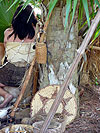 Calusa Indians Calusa Indians
Builders of shell-mounds and complex canal systems, the Calusa developed a
society, which included specialized classes of workmen, artisans, warriors,
priests and nobles. A non-agricultural people, they harvested the riches of
the mangrove estuaries, and politically dominated all of south Florida. They
fiercely resisted Spanish conquest, but succumbed to European diseases, disappearing
completely by 1740. Watch the Calusa make and use shell tools and palm-fiber
rope.
Spanish Camp
Los Hombres de DeSoto: Arriving in La Florida with Ponce DeLeon, then later
with Hernando DeSoto, soldiers, explorers, and adventurers sought to tame this
hostile new land and its inhabitants for the Spanish Crown. Spain established
a string of mission-forts and the city Saint Augustine in north Florida, but
all their attempts to gain a foothold here eventually failed. Be sure to see
their authentic armor, military equipment and horses!
Seminole
In the early 1700’s, Creek Indians from Georgia and Alabama began moving
in Spanish Florida. They were soon joined by runaway African slaves and members
of other Indian tribes. Together, this rich mix of peoples became known as
the Seminole. Conflicts with English colonists first, then later with the American
settlers, pushed the Seminole ever southward. Adapting to the climate and resources
of the Everglades, they developed the open-sided shelter or “chickee”.
Each Seminole camp consists of a cluster of these chickees for living, sleeping
and a separate chickee for cooking, and preparing food.
British Infantry
The British redcoats you’ll see here are from the 60th Regiment of Foot.
Military survey parties like this one were sent to map and explore when Spain
gave up Florida to Great Britain in 1763. England made little attempt to settle
and colonize the vast Florida wilderness, limiting their 20 years of occupation
to the established coastal towns of Saint Augustine, and Pensacola. During
the American Revolution, Florida remained loyal to the King and became a refuge
for loyalists.
Continental Soldiers
The citizen army that George Washington inherited in 1775 consisted of militiamen
and independent companies of soldiers recruited throughout the Thirteen Colonies.
Most had to find their own arms, ammunition and equipment and adopted a wide
variety of uniforms. American soldiers wore green, white blue, brown and even
purple and red coats at different times during the Revolutionary War, depending
on what was available. No uniform regulations for the whole army were issued
until 1779, when General Washington divided the states into groups and assigned
dark blue coats with different colored cuffs, collars and lapels. The American
Continental soldiers at the Old Florida Festival are veterans from the Museum’s
Colonial Guard and is dressed in the uniform that was ordered for soldiers
from Georgia, North and South Carolina in the closing years of the war.
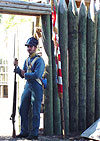 Seminole War Fort Seminole War Fort
Between 1817 and 1858, the United States fought three wars against the Seminole.
The first resulted in the purchase of Florida by U.S. The Second Seminole War,
fought between 1835 and 1842, was the longest, most expensive and bloodiest
Indian War in U.S. history. Over 4000 Seminole were killed or deported from
Florida, as the U.S. government forcibly relocated all of the eastern Indian
tribes to government reservations west of the Mississippi River. The Seminole
Wars were the only Indian Wars where the U.S. Navy took part in the fighting.
Our replica Seminole War fort is built in the most common style. These rough
outposts were hastily constructed to provide protection to soldiers and supplies.
Our soldiers represent the 4th U.S. Infantry, which served here in Southwest
Florida, when several hundred Seminole made a gallant last stand in 1855, during
the Third Seminole War.
Civil War Camps
When Confederate cannons opened fire on Fort Sumter, South Carolina, in April
1861, Floridians suddenly found themselves in a shooting war with U.S. government.
Despite its small population, and shortage of military uniforms and equipment,
Florida would supply more than 15,000 fighting men to the Confederacy and about
1,200 to the Union army. Our Civil War Camp has units from the 10th Florida
Infantry, 1st U.S. Artillery, and the Union Navy, that so effectively blockaded
Florida’s long coastline, cutting off foreign re-supply of food, medicine
and ammunition to the Confederacy.
The colorful Zouave regiment was one of many
Civil War volunteer units that took the field in flamboyant uniforms, inspired
by the dress of elite French
soldiers in North Africa.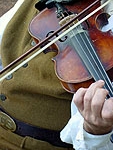
Telegraph Station
The Internet of the 1870’s, the telegraph sped messages from coast to
coast in seconds. Wires connected the frontier with big cities and brought
both news and financial information. Telegraphers had to have good, fast penmanship
and understand Morse code. Send a message or learn how your name is spelled
in code.
Medicine Show
Traveling medicine shows brought “patent medicines” to
the frontier. Pioneers treated a variety of ailments (both man and beast) with
varying results.
See Dr. Esterline’s magic and medicine show to capture the flavor of
this popular attraction.
Apothecary Shop
An apothecary shop sold medicines of all kinds formulated by a trained druggist.
As more doctors moved to the frontier, drug stores sprung up to supply the
medical trade. An apothecary shop could fit a wooden leg, make dentures and
sell eyeglasses, soap, liniment and patent medicines as well.
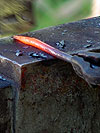 Pioneer Life Pioneer Life
The harsh economic climate of Reconstruction after the Civil War led some hardy
families to move to the Southwest Florida frontier to star anew. Coming by
oxcart, and sailboat, they cleared land, built cabins of plentiful pine and
cypress, and supported their families by hunting, fishing, and farming. Proud,
independent, and resourceful, these first pioneers grew or made nearly everything
they needed to survive and prosper in the Florida wilderness. Glimpses of pioneer
life are provided by our crafts folk, blacksmith, General Store, and traveling
Medicine Show. If you think you’ve seen and heard everything, be sure
to have your head examined by the only practicing Phrenologist south of Tallahassee!
Spanish American War
Called “a splendid little war” by Secretary of State John Hay,
the Spanish American War propelled the United States onto the stage of world
politics. The war against Spain also helped heal the great rift left by the
Civil War, as boys from both north and south fought side by side as Americans,
once again. The war provided by US with a colonial empire, which included Cuba,
Puerto Rico and the Philippines.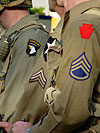
World War II
From 1942 to 1945 the third largest city in Florida was one of the Army’s
training facilities. Thousands of soldiers and pilots trained at the Naples
airfield. Many of them returned after the war to buy property or take up residence.
Sherman Tank
Nearly 50,000 of these armored fighting vehicles were produced
to aid the Allied war effort from 1940 to 1945. The Sherman tank served throughout
the European
Theater, in North Africa, and the Pacific.
Sutlers & Traders Row
Traditional food, snacks, art, gifts, and articles of interest to history buffs
are available for sale at our festival vendors. Take some time to tour Trader’s
Row and do some serious tradin’.
Folk Music – Banjos Unlimited
The Musgroves, a husband and wife team, who specialize in songs of the Civil
War are bring their special blend of music and country humor.
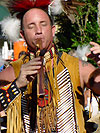 |
Ed Winddancer
Authentic Native American dancer, Ed Winddancer demonstrates traditional music
and dance. |
Cane Grinders
A fall tradition throughout cracker country, making sugar kept the pioneer
family busy cutting and hauling sugar cane. The animal powered cane grinder
squeezed the juice from the raw cane. The juice was boiled down to produce
sugar, molasses or sugar loaf. An ideal crop for the Florida frontier, sugar
cane grew well, could be harvested for several years from the original planting,
shipped easily and did not spoil.
|
